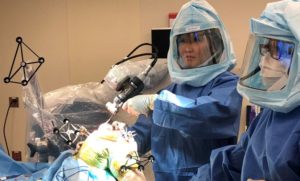
Since 2019, Antonia F. Chen, MD, MBA, and several orthopaedic surgeons at Brigham and Women’s Hospital have been performing partial and total knee replacements using robotic-arm assisted surgery.
To date, Brigham surgeons have performed partial and total knee arthroplasty on more than 150 patients using Stryker’s Mako™ system. Several medical centers in the Northeastern U.S. are using this robotic system for research purposes, but the Brigham is among a select group using it in a clinical setting.
“At the Brigham, we are always striving to improve patient outcomes with innovative approaches and new technology. We were early adopters of same-day knee replacement, 3D custom knee implants, and now the adoption of this cutting-edge robotic technology,” says Dr. Chen, a hip and knee surgeon in the Department of Orthopaedic Surgery at Brigham and Women’s Hospital.
Robotic System Improves Patient-Reported Outcomes
Dr. Chen has almost two years of experience using the robotic system to replace knees. As a principal investigator in the recent study, “Post-Market Study of Robotic-Arm Assisted Total Knee Arthroplasty,” Dr. Chen and her colleagues compared outcomes when total knee arthroplasty was performed manually or using the robotic system.
Results of this study showed that component placement was more accurate using the robotic technology. Even on radiology rounds, Dr. Chen observed that X-rays of patients who had undergone a knee replacement via the robotic technology showed more precise leg alignment compared to manual surgery.
A 2019 study in the Journal of Knee Surgery, which compared manual surgery with robotic surgery, showed higher patient satisfaction with the robotic system. Another 2019 study in Surgical Technology International demonstrated improvements in the knee outcomes KOOS, VR-12 and SF-12 when using robotic technology.
“The most impressive outcome has been an increase in patient-reported outcomes. Many of my patients report that their knee implant feels “more natural” when replaced with the robotic technology,” says Dr. Chen.
Enhanced Implant Precision May Drive Improved Patient Outcomes
Using this robotic system, an orthopaedic surgeon can only make cuts within the haptic boundary. For example, if a surgeon were to cut too close to the posterior cruciate ligament (PCL), the machine would stop, resulting in less damage to surrounding tissues and ligaments.
About 100 peer-reviewed publications have shown that such precision can result in short-term benefits, including less post-operative pain, less opioid drug use, reduction in length of stay, and fewer readmissions due to complications from the procedure.
“This robotic system brings orthopaedic surgery closer to the reality of personalized medicine, because it presents data based on the patient’s unique anatomy, allowing surgeons to make extremely precise adjustments during surgery,” says Dr. Chen.
Such improvements may also represent a positive step forward in the effort to increase patient satisfaction among total knee arthroplasty patients who are dissatisfied with their outcomes due to limited mobility, increased pain, or even just an inability to perform activities with the same intensity or duration.
Studying Long-Term Outcomes with the Robotic Technology
While the robotic system has shown many benefits, 10- and 20-year outcomes data still don’t exist, and long-term studies are required. As such, there’s still no indication that the use of this robotic system extends the longevity of knee implants.
“Our long-term plan is to continue studying this exciting technology in our patient population and contribute outcomes data to the growing literature,” says Dr. Chen.
Ultimately, Dr. Chen and her colleagues aim to follow patients for 20 to 30 years to understand how this technology may improve the average lifespan of knee implants.
“What I love about the Brigham is that it’s always about the patient. Even if a technology costs more or a surgical approach takes longer, we will do whatever it takes to improve outcomes for our patients,” says Dr. Chen.